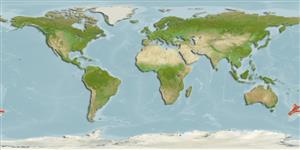Elasmobranchii (tubarões e raias) (sharks and rays) >
Carcharhiniformes (Ground sharks) >
Triakidae (Houndsharks) > Triakinae
Etymology: Mustelus: Latin for weasel, an ancient name for sharks, possibly referring to the pointed snouts, swift movements and/or rapacious feeding behavior of smaller predatory sharks [strictly not tautonymous with Squalus mustelus Linnaeus 1758 since type was designated by the ICZN]. (See ETYFish); lenticulatus: Latin for freckled, referring to peppering of white spots on upper sides. (See ETYFish).
Environment: milieu / climate zone / depth range / distribution range
Ecologia
marinhas demersal; oceanódromo (Ref. 54100); intervalo de profundidade 0 - 860 m (Ref. 26346), usually 0 - 400 m (Ref. 89422). Subtropical; 34°S - 48°S
Southwest Pacific: Kermadec Islands (Ref. 8879) and New Zealand; reported from southern Australia (Ref. 9258).
Comprimento de primeira maturação / Tamanho / Peso / Idade
Maturity: Lm 90.9, range 79 - 100 cm
Max length : 125 cm TL macho/indeterminado; (Ref. 9072); 151.0 cm TL (female); common length : 85.0 cm TL macho/indeterminado; (Ref. 9258)
Found on the insular shelves, often close inshore (Ref. 244). Feeds on crustaceans, especially crabs (Ref. 244). Ovoviviparous (Ref. 50449). Makes seasonal inshore-offshore movements (Ref. 244). Makes extensive coastal migrations, with one tagged female moving at least 1160 km (Ref. 54100). Forms schools separated by size and sex (Ref. 244). Utilized fresh for human consumption (Ref. 244).
Ovoviviparous, embryos feed solely on yolk (Ref. 50449). With 2 to 37 young born at 20-32 cm (Ref. 26346).
Compagno, L.J.V., 1984. FAO Species Catalogue. Vol. 4. Sharks of the world. An annotated and illustrated catalogue of shark species known to date. Part 2 - Carcharhiniformes. FAO Fish. Synop. 125(4/2):251-655. Rome: FAO. (Ref. 244)
Status na Lista Vermelha da UICN (Ref. 130435)
Ameaça para os humanos
Harmless
Uso pelos humanos
Pescarias: espécies comerciais; peixe esportivo: sim
Ferramentas
Relatórios especiais
Baixar XML
Fontes da internet
Estimates based on models
Preferred temperature (Ref.
123201): 8.6 - 18.3, mean 13.7 °C (based on 370 cells).
Índice de diversidade filogenética (Ref.
82804): PD
50 = 0.5000 [Uniqueness, from 0.5 = low to 2.0 = high].
Bayesian length-weight: a=0.00186 (0.00109 - 0.00319), b=3.14 (2.99 - 3.29), in cm total length, based on LWR estimates for this species & Genus-body shape (Ref.
93245).
Nível Trófico (Ref.
69278): 3.5 ±0.3 se; based on diet studies.
Generation time: 10.0 ( na - na) years. Estimated as median ln(3)/K based on 2
growth studies.
Resiliência (Ref.
120179): Baixo, tempo mínimo de duplicação da população 4,5 - 14 anos (tmax=12+; K=0.11-0.16; tm=3-4; Fec=2-23).
Fishing Vulnerability (Ref.
59153): Very high vulnerability (77 of 100).
Climate Vulnerability (Ref.
125649): Very high vulnerability (77 of 100).
Nutrients (Ref.
124155): Calcium = 15.1 [4.6, 75.0] mg/100g; Iron = 0.449 [0.142, 1.704] mg/100g; Protein = 21.5 [19.2, 23.7] %; Omega3 = 0.149 [0.062, 0.352] g/100g; Selenium = 53.5 [16.3, 197.5] μg/100g; VitaminA = 6.83 [2.27, 20.29] μg/100g; Zinc = 0.619 [0.272, 1.268] mg/100g (wet weight); based on
nutrient studies.
